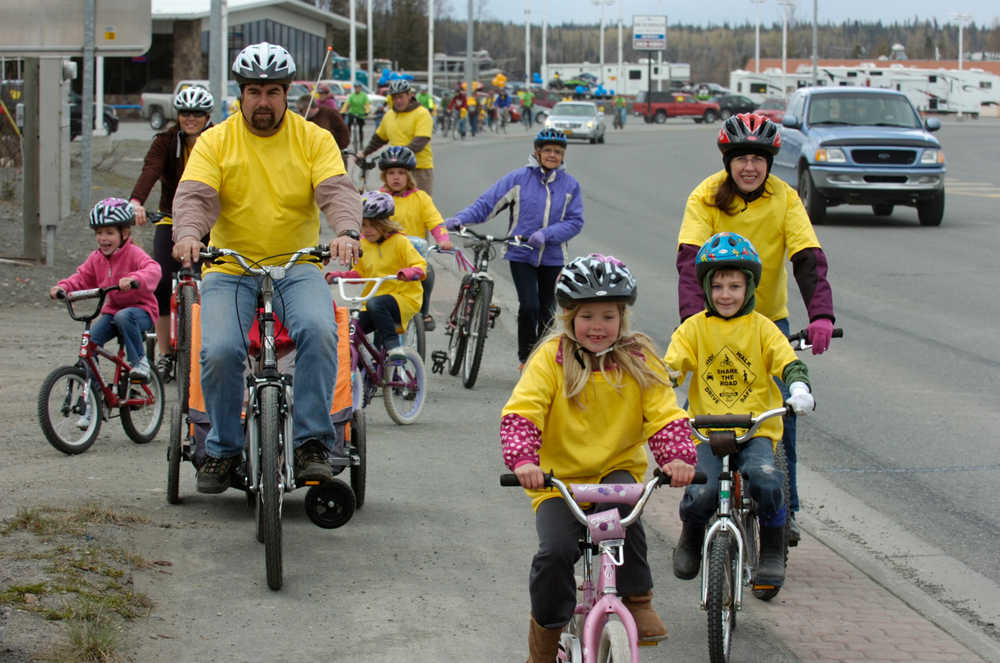The third draft of the City of Soldotna’s Safe Routes to Schools Walk Zone Inventory and Recommendations Draft was met with public support and lingering concerns, at a Wednesday meeting.
At the meeting, Soldotna City Council and Planning and Zoning Commission members responded to and reiterated public hesitation over increasing traffic flow access points, which may actually create more problem areas for children commuting on bicycles.
Patrick Cotter, a representative of Fairbanks-based PDC Inc., Engineers, presented recommendations and costs for potential walk zone projects. Walk zones are defined as a half-mile radius around a school. He discussed the installation of several Rectangular Rapid Flash Beacons (RRFBs) at various crosswalks around the city.
Cotter said nothing is set in stone. Modifications for the next version will focus on creating more accessible connections from main routes to Skyview Middle School, and improving the existing routes around Soldotna Elementary School, he said.
Soldotna Elementary and Soldotna Montessori are of interest because they are bordered by two major roads, the Kenai Spur Highway and Binkley Street, which see an average of more than 13,000 vehicles per day, according to the draft.
Cotter said the goal is to finalize plans by the end of the school year. However, City Planner John Czarnezki said he hopes to have the walk zone plans completed in early spring, before school ends, so the city can propose it to the Alaska Department of Transportation and Public Facilities if or when more federal grant money through the Safe Routes to School Program is announced.
The program will reimburse 100 percent of the funding necessary to complete approved planning, non-infrastructure, infrastructure or single projects, according to ADOT. A previous safe routes to school grant funded the labor required to complete the walk zone inventory.
The walk zone draft outlines the projected cost of each individual project, Czarnezki said.
Chosen projects will be supplemented through municipal and federal funding, Czarnezki said. Some may begin soon, some may take 10 years others may never happen, he said.
The council will better know how to budget for the remaining projects after seeing if any are awarded federal grant money.
Safe Routes to School has been granting money to states since 2005 for the purpose of encouraging more students, including those with disabilities, to commute on foot or bicycle and improving safety along existing routes while reducing traffic and therefore fuel consumption and air pollution, according to the Federal Highway Administration.
Every year states will receive no less than $1 million dependent on student enrollment in primary and middle schools, according to the Highway Administration. The state then decides how to allocate the funds from grant proposals.
Soldotna’s plan qualifies as an infrastructure project, which can include installing or altering existing sidewalks, traffic diversion programs, pedestrian and bicycle crossing improvements and traffic calming and speed reduction, according to ADOT.
“It will be a powerful tool for the city to have,” said Stephanie Queen, director of economic development and planning.
The primary objectives of initial assessments focused on increasing the number of students walking or biking to school, improving safety around schools, and reducing traffic and air pollution near schools, according to the draft plan.
PCD Inc. engineers compiled information through site visits, geospatial data collection and parent surveys for the inventory process. Planners labeled the projects as priority levels one through three based on their immediate to no need for safety improvement.
Assessments found Cook Inlet Academy, Kalifornsky Beach Elementary, Redoubt Elementary, Soldotna Elementary, Soldotna Montessori and Skyview Middle School all have areas requiring safety modifications. CIA reported that no students walk or bike to school, but the survey found the potential to increase this.
Assessments oriented toward safe routes to school programs make sure project architecture implements the “five E’s” — evaluation, engineering, education, encouragement and enforcement.
Zoning Commission member Colleen Denbrock said Soldotna should also try to target education as an important aspect of these safety features.
“None of this will work if we don’t have education for adults too,” Denbrock said.

